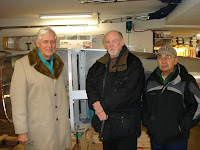Wow folks, it has been five months since I have updated my blog. That is pitiful and I have no excuse. But I have been busy since then.
The next step in the airplane construction is the engine and avionics. This was the event where I wrote the two largest personal checks ever. Talk about being choked up. But the engine and avionics packages came complete, intact and undamaged.
I first installed the servos for the two-axis auto pilot option. That required the installation of additional structural bracketry which was difficult to install at this stage of construction but was accomplished none the less.

Then attaching and wiring the servos, one for roll control (flaperons) and one for pitch control (stabilator). The wonderful thing about this Van's RV12 kit is that all of the parts are included - all nuts, bolts, washers, fittings, clamps, etc. This means no shopping trips to Home Depot (airplane people don't really buy hardware there, do they?) or Spruce aviation hardware on the web. It also means that all of the parts and pieces and bits are exactly right for the intended application. It offers a lot of confidence to me, the builder and eventual flier.

The instrument panel was prewired with all of the switches and fuses and connectors and was a simple matter to connect computer style db cables between the radio, transponder, GPS and Dynon180 EFIS.
(Electronic Flight Information System).

This glass panel replaces the six common round, mechanical gauges previously found in airplanes.
I had to mill a rectangular slot in the panel to install the auto pilot control head and that fit perfectly.

The next task was the getting the airframe on it's gear.

Then came the installation of the fire wall forward equipment or FWF as those in the know call it. This included all of the wiring and relays and starter solenoid and battery and 12 volt connectors and so on.

Then the engine. The single largest cost item had as it's first instruction, "take a hacksaw and saw a lug off of the starter motor".

Gulp! It was not needed in this application and would interfere with the engine mount anyway.
Then the entire top of the engine had to be stripped to allow the precise fitting of a cooling shroud for the cylinders.

This engine is unlike other aviation piston engines in that it has air-cooled cylinders but water-cooled cylinder heads. That will necessitate a water radiator. The engine was re-assembled and then mounted to the aircraft. Gee, I thought that maybe this airplane thing will work out after all. Then came the fitting of the engine cowling, the glassing of the radiator cooling duct,

the fitting of the oil radiator, attaching the propeller and the spinner with the little pitot tube sticking out of the center looking like a miniature machine gun.
This test was determining the cylindricity of the pitot tube.

At this stage, two small lower fuselage close-out pieces were riveted and that was that!


Now things were coming together really fast.

At this point, pretty much everything was done that I could do in my garage. The vertical stabilizer, horizontal stabilator and wings had to be attached to continue. Out to the airport. My two crew, Terry the neph and Dan the friend since 1964.

On the trailer.



Now in the hanger after all the remaining stuff is attached. Now control cable tensions had to be set and clearances set for all moving parts. Nothing can stick or jam



A fuel system integrity and fuel pump performance test was done. The engine, having a dry sump, has to have the oil system purged to insure oil is where it is supposed to be prior to the first start.
Then came the first start. My crew was there with fire extinguishers and my S.O.was there for support and picture taking.

Wow! she is ALIVE!
Following that was calibration of the static system and pitot system. Then an software update for the Dynon was done using a laptop with downloaded programs and a computer port in the airplane. Everything has worked well so far.
Taxi tests were performed and on the third one, my left tire went instantly flat.

This occurred on the main taxiway and I had to have the plane ignominiously towed to the repair hanger. The inner tube had a slice in it, not from being pinched but more like being cut with a box cutter.

All I can imagine is that during this tube's transit from it's origin to Oregon, perhaps someone wrapping or unwrapping caused the cut. The scary thing though is it held air since I originally inflated it in May and there were two previous taxi tests. I am glad it failed now instead of during my first landing. Yikes! Somebody up there likes me.
All that remains is a fuel system calibration and a compass calibration. I am still waiting on the FAA for my registration so I can hire a DAR for the airworthiness inspection. I've been told that when the weight of the paperwork equals the weight of the plane, then the FAA will be satisfied. After that inspection - first flight.
I'll post the results.
Thanks for reading my blog.






































 And this when completed...
And this when completed...






